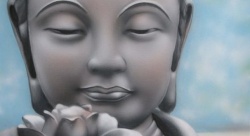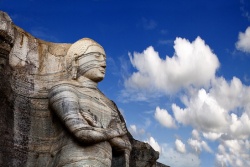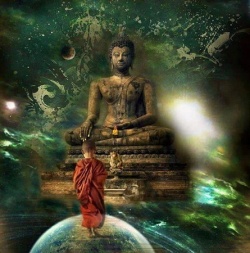Self-nature
By Barbara O'Brien
Among all the Buddha's teachings, those on the nature of the self are the hardest to understand, yet they are central to the religion. In fact, "fully perceiving the nature of the self" is one way to define enlightenment.
The Five Skandhas
The Buddha taught that an individual is a combination of five aggregates of existence, also called the Five Skandhas or the five heaps. These are:
Form
Sensation
Perception
Mental formations
Consciousness
Various schools of Buddhism interpret the skandhas in somewhat different ways. Generally, the first skandha is our physical form. The second is made up of our feelings, emotional and physical, and our senses -- seeing, hearing, tasting, touching, smelling.
The third skandha, perception, takes in most of what we call thinking -- conceptualization, cognition, reasoning. This also includes the recognition that occurs when an organ comes into contact with an object. Perception can be thought of as "that which identifies." The object perceived may be a physical object or a mental one, such as an idea.
The fourth skandha, mental formations, includes habits, prejudices and predispositions. Our volition, or willfulness, also is part of the fourth skandha, as are attention, faith, conscientiousness, pride, desire, vindictiveness, and many other mental states both virtuous and not virtuous. The causes and effects of karma are especially important to the fourth skandha.
The fifth skandha, consciousness, is awareness of or sensitivity to an object, but without conceptualization. Once there is awareness, the third skandha might recognize the object and assign a concept-value to it, and the fourth skandha might react with desire or revulsion or some other mental formation. The fifth skandha is explained in some schools as base that ties the experience of life together.
The Self Is No-Self
What's most important to understand about the skandhas is that they are empty. They are not qualities that an individual possesses, because there is no-self possessing them. This doctrine of no-self is called anatman or anatta.
Very basically, the Buddha taught that "you" are not an integral, autonomous entity. The individual self, or what we might call the ego, is more correctly thought of as a by-product of the skandhas.
On the surface, this appears to be a nihilistic teaching. But the Buddha taught that if we can see through the delusion of the small, individual self, we experience that which is not subject to birth and death.
Two Views
Beyond this point, Theravada Buddhism and Mahayana Buddhism differ on how anatman is understood. In fact, more than anything else it is the different understanding of self that defines and separates the two schools.
Very basically, Theravada considers anatman to mean that an individual's ego or personality is a fetter and delusion. Once freed of this delusion, the individual may enjoy the bliss of Nirvana.
Mahayana, on the other hand, considers all physical forms to be void of intrinsic self (a teaching called shunyata, which means "emptiness"). The ideal in Mahayana is to enable all beings to be enlightened together, not only out of a sense of compassion, but because we are not really separate, autonomous beings.


